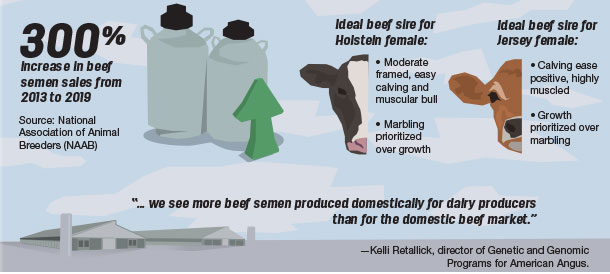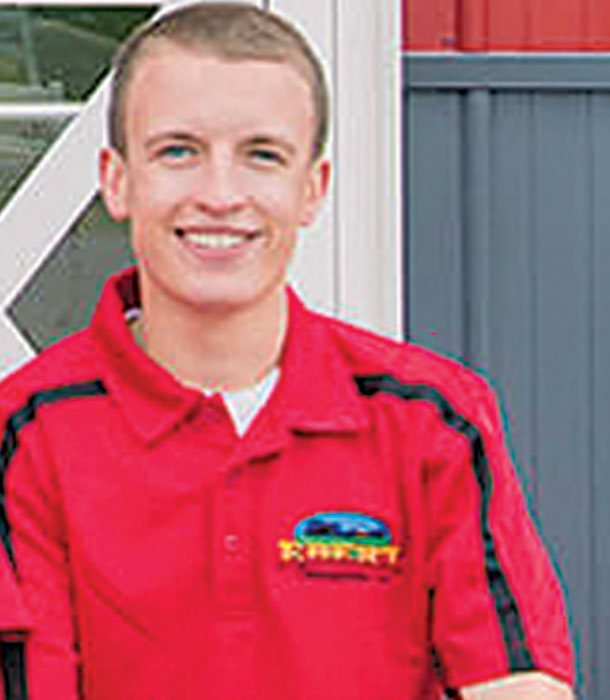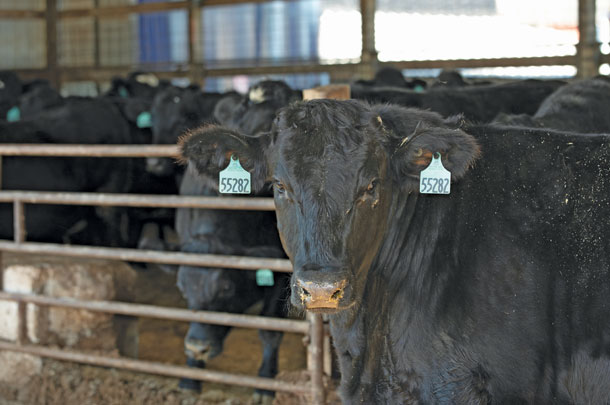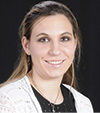Beef producers and breed associations are also paying special attention to this prolific market.
Late last year, the American Angus Association (AAA) released their own unique dollar index to select the best sires to mate to dairy cattle. The research, conducted by Drs. Steve Miller and Jason Archer, was presented at the 2020 Beef Improvement Federation Conference.
“This is really about genetic selection,” Archer explains. “There were (different) things we need to target compared to what we would normally do for a beef cross index.”
Angus is not the only breed to receive growing attention from the dairy sector. In 2019, the American Simmental Association (ASA) and Holstein Association USA released HOLSim, their own dollar index for Holstein-specific matings.
Limousin genetics have also grown significantly in both Jersey and Holstein circles.

Collectively, beef semen sales have grown significantly – up near 300% for some from 2013 to 2019, according to the National Association of Animal Breeders – largely due to the rising demands from dairy producers.
While several beef breeds boast many nice characteristics that pair with dairy carcass characteristics, not just any sire will do the job.
The dairy carcass qualities
Many dairies have opted to incorporate beef semen to their breeding strategies to maximize value of calves from cows with low genetic merit. But when it comes to meat quality, dairy breeds certainly aren’t lacking.
Overall, both Jerseys and Holsteins tend to have some decent carcass characteristics. Even with frames exemplifying dairy strength, they tend to store a good amount of it as intramuscular fat. These show up as “flecks of flavor” on a ribeye or other cut – better known as marbling.
The places beef sires enhance value are growth, efficiency and certain carcass characteristics. These areas make crossbred calves worth more to the feeding and finishing segments.
“We see this pattern happening, and we are to a point where we see more beef semen produced domestically for dairy producers than for the domestic beef market,” says Kelli Retallick, director of genetic and genomic programs for American Angus.
The Angus breed has particularly been focused on strong maternal traits such as calving ease, fertility and shorter gestation periods.
“These were a huge draw from a dairy producer’s perspective,” she says. “Angus also excels in feedlot performance, like post-weaning gain and feed intake, when we compare the straight-bred Angus steer to the traditional dairy steer that was entering the marketplace.”
Additionally, the breed has a lot of premiums and the largest, including the most well-known, branded beef program in the world – Certified Angus Beef brand – that makes for very viable marketing opportunities.
The beef sector responds
For Ebert Enterprises in Algoma, Wisconsin, beef semen has allowed the increase of selection intensity for their dairy animals while making additional income raising and selling dairy beef crosses.
About 80% of their cow herd is bred to beef, with the top 20% getting sexed semen.

“This has really allowed us to leverage our selection intensity,” says Jordan Ebert, head of business development for Ebert Enterprises. “It’s worked for us, and we don’t want to change anything.”
In response to such feedback, associations and stud companies from the beef and dairy sides continue to collaborate.
Influenced by both Jersey and Holstein producers, the Angus Association opted to have distinct indexes to account for the considerable differences.
The Holstein index, Archer explains, was developed to penalize certain bulls who are too high in growth and frame size.
“The way we describe it is: You want a moderate-framed, easy-calving and muscular bull,” he says. “These sires need to prioritize marbling over growth.”
For Jerseys, the formula is nearly reversed. Ideal sires for Jersey crosses are bulls who prioritize growth over marbling while still being calving ease-positive and highly muscled.
“From a farmer’s point of view, it’s designed to be simple,” says Archer.
While Angus continues to top the amount of beef semen sales by volume, Continental beef breeds are leading in growth percentages. Simmentals and Limousins, Continental breeds originating from Switzerland and France, are next in line for number of units sold behind Angus.
HOLSim, the ASA and Holstein USA’s Beef x Holstein terminal beef index, was developed to utilize the serious genetic decision-making approach already embraced by dairy producers to more ideally match beef sires with Holstein cows.
Power in crossbreeding
Since 2018, the ASA has also investigated beef-on-dairy strategies. That ultimately resulted in collaborating with Holstein USA, explains Chip Kemp, ASA director.

The early stages involved going through the entire International Genetics Solutions database (of which ASA is a part) and the AAA databases to see what bulls met an initial threshold.
According to Kemp, 89% of the bulls meeting these ideal beef-on-dairy benchmarks were composite, or crossbred, animals. And of that composite bull group, approximately 89% of those were SimAngus.
Obviously, SimAngus were not the only bulls working to the top, but they did provide critical mass. As a result, it was decided by Holstein USA to zero in on elite SimAngus bulls specifically.
And this isn’t a surprise; modern SimAngus genetics promote moderate frame size, increasingly homozygous black and polled, and have desirable muscle characteristics needed to complement a Holstein’s.
“This is mostly seen with the orientation of the ribeye to avoid dairy discounts in the packer,” Kemp says. “We can also look at carcass yield or muscle mass. Genetics for marbling, while clearly of high economic importance and a key component in the HOLSim index, are not quite as crucial in these matings as muscle confirmation, carcass yield and appropriate carcass length.”
Overall, bulls making the HOLSim list are elite in these areas.
Other criteria in the index are homozygous polled, homozygous black, SimAngus bulls that are three-eighths to three-quarters Simmental with no other breed influence outside Angus, and a minimum birthweight accuracy level.
“We’ve been working on creating more of a composite breed,” Ebert says, noting they have increasingly used more SimAngus sires. “At this point, we have had about 2,800 head of dairy beef animals we’ve raised from birth to finish.”
Working with ABS, he says their program has been tailored specifically to their farm. Ultimately, they have built a system that caters to beef customers while increasing the quality of their dairy herd.
“Dairymen and women who want to be progressive should think about this strategy and how it can be customized to their specific operations,” he says. “There’s a lot of opportunity in it. Although the beef and dairy markets fluctuate greatly, as any major commodity industry, I think over time it’s a sustainable strategy and practice for the industry.” ![]()
PHOTO 1: More and more dairies have opted to incorporate beef semen into their breeding strategies to maximize value of calves from cows with low genetic merit and manage heifer inventory.
PHOTO 2: Jordan Ebert, head of business development for Ebert Enterprises, Algoma, Wisconsin
PHOTO 3: Ebert Enterprises in Algoma, Wisconsin, has raised about 2,800 head of dairy-beef cross calves from birth to finish. Photos courtesy of ABS Global.
Jaclyn Krymowski is a freelancer based in Ohio.






